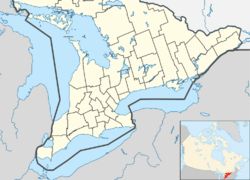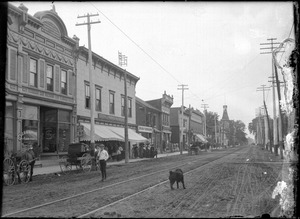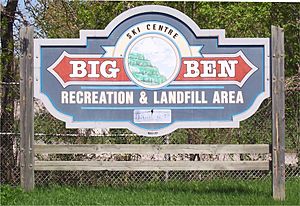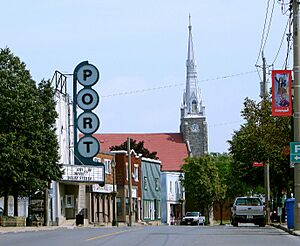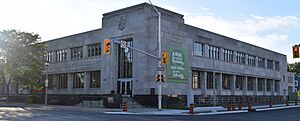Cornwall, Ontario facts for kids
Quick facts for kids
Cornwall
|
|||||
|---|---|---|---|---|---|
 |
|||||
|
|||||
| Nickname(s):
The Friendly City, The Seaway City, The Friendly Seaway City
|
|||||
| Motto(s):
Pro Patria
|
|||||
| Country | Canada | ||||
| Province | Ontario | ||||
| County | Stormont, Dundas and Glengarry | ||||
| Founded | 1784 | ||||
| Area | |||||
| • Land | 61.50 km2 (23.75 sq mi) | ||||
| • Urban | 32.40 km2 (12.51 sq mi) | ||||
| • Metro | 509.21 km2 (196.61 sq mi) | ||||
| Elevation | 64.00 m (209.97 ft) | ||||
| Population
(2021)
|
|||||
| • Total | 47,845 | ||||
| • Density | 777.9/km2 (2,015/sq mi) | ||||
| • Urban | 47,286 | ||||
| • Urban density | 1,459.6/km2 (3,780/sq mi) | ||||
| • Metro | 61,415 | ||||
| • Metro density | 120.6/km2 (312/sq mi) | ||||
| Metropolitan area includes the City of Cornwall and South Stormont Twp. | |||||
| Time zone | UTC−5 (EST) | ||||
| • Summer (DST) | UTC−4 (EDT) | ||||
| Postal Code FSA |
K6H to K6J
|
||||
| Area code(s) | 613, 343 | ||||
Cornwall is a city in Eastern Ontario, Canada. It's located where the provinces of Ontario and Quebec meet the U.S. state of New York. Cornwall is the main city for the United Counties of Stormont, Dundas, and Glengarry. It is also Ontario's easternmost city.
The city is named after the Duchy of Cornwall in England. Cornwall's coat of arms looks like the Duchy's, but with different colors. It also has a "royal tressure," which is a Scottish symbol of royalty.
Cornwall is a central hub for nearby towns. These include Long Sault, Ingleside, and Akwesasne, which is a Mohawk Territory. It also serves St. Andrews West, Avonmore, Glen Walter, Martintown, Apple Hill, Williamstown, and Lancaster.
The city sits along the St. Lawrence River. It is home to the St. Lawrence Seaway Management Corporation. This group manages shipping activities on the St. Lawrence Seaway. Cornwall is a major entry point from the United States into Canada. Its location helps support big industries like logistics, distribution, and call centers.
Contents
History of Cornwall
Indigenous peoples have lived in the Cornwall area for thousands of years.
The first recorded European settlement began in 1784. It was started by United Empire Loyalists from the former British colony of New York. In 1787, Prince William Henry (who later became King William IV) visited this settlement. He was the first member of the royal family to visit what is now Ontario.
After the American Revolutionary War, soldiers loyal to the Crown settled here. The town was first called New Johnstown. Many new arrivals were German. The town was named after Johnstown, New York, where many of them came from.
A main group was led by Lieutenant-Colonel Sir John Johnson. They were soldiers from the King's Royal Regiment of New York. Many people who supported the British moved to Canada after the American Revolution. The British government helped them settle in areas like the St. Lawrence River Valley. This area became known as "Loyalist Country."
They built a permanent settlement near some portage points. These points were called Pointe Maligne by European explorers. The town was first called "Royal Town #2" or "New Johnstown." Later, it was renamed Cornwall for the Duke of Cornwall by Prince George (who became King George IV). In 1834, Cornwall became one of the first incorporated municipalities in Upper Canada.
During the War of 1812, battles like Hoople's Creek and Crysler's Farm happened nearby. The American Army occupied Cornwall from November 11-13, 1813.
The Cornwall Canal was built between 1834 and 1842. This helped the community grow into an important economic center. By 1846, Cornwall had about 1,600 people. It had many brick and stone houses, a courthouse, and government offices.
Building canals and locks in the late 1800s and early 1900s brought more work. The Grand Trunk Railway (now CN Rail) built a line through Cornwall in 1856. The New York and Ottawa Railway (NY&O) added a line in 1898. The Canadian Pacific Railway also built a line, the Glengarry and Stormont Railway, in 1915. This connected Cornwall to Montreal.
These railway links connected Cornwall to nearby communities. People could access high schools and medical services in Cornwall. This helped Cornwall become a regional center for business and services.
In 1944, a 5.8 magnitude earthquake shook the city. No one died or was injured. However, many chimneys were damaged, and old stone buildings suffered heavy damage. For example, the Cornwall Collegiate and Vocational School had its gymnasium roof damaged by falling masonry.
West of Cornwall, along the St. Lawrence River, were several small communities called the Lost Villages. They were flooded in 1958 when the St. Lawrence Seaway was built. This created a reservoir for the Moses-Saunders Power Dam. The dam helps control water levels from Lake Ontario and powers two Canada-US hydroelectric stations.
People and Culture
Diverse Backgrounds
The Cornwall area has a rich history of different groups of people living together. First, there were French Canadian, Ojibwe, and Mohawk residents. Then came American Loyalists and refugees from the Thirteen Colonies. Other French Canadian and Acadian migrants also arrived.
Later, poor Scottish and Irish immigrants came from overseas and other parts of Canada. Over time, these groups mixed and integrated. Family names and histories in Eastern Ontario often show this blend of different backgrounds.
Other groups also made important contributions. These included Jewish traders, craftsmen, and merchants. There were also refugees from Eastern Europe and former slaves. Many of these stories are not widely known. For example, John Baker, who died in Cornwall in 1871, was born into slavery in Lower Canada. He was a soldier in the War of 1812.
Slavery was ended in Upper Canada in stages. In 1793, importing slaves was banned. By 1819, all slaves in the colony were declared free. This made Upper Canada the first place in the British Empire to formally abolish slavery. Most former slaves settled in the communities where they were freed. By 1833, slavery was abolished throughout the British Empire.
After the Seven Years' War, "Canada" was conquered from France. It included areas now known as Quebec and Ontario. After the American Revolution, the British divided the Province of Canada in 1791. Upper Canada was for English settlers, and Lower Canada was for the French. This helped Loyalists who fled the United States. Many French settlers also moved into Ontario.
The first 516 settlers in "Royal Township #2" (later Cornwall) arrived with few supplies. They faced years of hard work. They were given tents, food, clothes, and farm tools. For three years, boats delivered food. After that, they had to manage on their own. This led to a local culture of being very self-reliant.
Working Together
The Cornwall region was known for people working together. For hundreds of years, people from different backgrounds mixed. This was common because they depended on each other. There was little support from outside authorities.
The original Native population was very welcoming. The Iroquois were known for including newcomers into their societies. Many people in the region have some Native ancestry. Many communities are on sites that have been used for hundreds of years.
There was not a strict social hierarchy. For example, from the 1780s to the 1830s, a "bee" was a social event. People would gather to help with big projects or to help individual families. These were often festive occasions. These early "bees" helped create a diverse culture. People from different classes and backgrounds had to work together to survive. These shared labor events were common in Eastern Ontario.
Susanna Moodie, a writer, noted that people loved to go to "bees." These gatherings showed that there was no aristocracy in the loyalist settlements. The hard life on the frontier united everyone in the community. Early Loyalists, no matter how much land they owned, relied on their neighbors. They helped each other clear land, build homes, and share food.
More recently, Cornwall has seen more new immigrants. They often fit in well and do better than immigrants in other parts of Canada.
Geography and Environment
Environment
Cornwall has faced environmental challenges due to past industrial pollution. The riverfront has been contaminated by mercury, zinc, lead, and copper. The soil has been polluted by coal tar. There is also "Big Ben," a large dump site within the city. It is filled with wood bark, paper mill waste, and asbestos.
In 2008, the government allowed more dumping at "Big Ben." This was despite public opposition and reports of pollution leaking into the St. Lawrence River. The area is meant for recreation, but it is often off-limits. It is only used as a ski hill in winter when the waste is covered and odors are less strong.
For years, industrial pollution in Cornwall caused health worries. In 1995, Health Canada reported that asthma hospitalizations were twice as high as in other industrial cities. Lung and male rectal cancer rates were also higher.
Air quality has improved since the Courtaulds rayon fiber factory closed in 1992. The Domtar paper mill also closed in 2006. Cornwall now often ranks among the top 10 cities in Ontario for air quality. A study by the Pembina Institute ranked Cornwall 13th overall for environmental factors. Its air quality was ranked #1 in the province.
Cornwall used to have only primary sewage treatment. But a new secondary treatment plant was finished in November 2014. The Canadian and Ontario governments helped pay for this $55.5 million project.
In 2006, the city decided to become an environmentally sustainable community. In 2007, a former city councilor started a project to reduce carbon. The city also began using a hot water district heating and cogeneration system in 1995. This provides about 4% of the city's daily electricity. It also heats buildings like a hospital and schools. In 2002, Cornwall changed all its traffic signals to energy-efficient LEDs. This reduced power use by over 600 kW.
Climate
Cornwall has a humid continental climate. This means it has cold, snowy winters and warm, humid summers. It rains or snows a lot throughout the year. Winter months are usually drier than summer months.
| Climate data for Cornwall, 1981–2010 normals, extremes 1867–present | |||||||||||||
|---|---|---|---|---|---|---|---|---|---|---|---|---|---|
| Month | Jan | Feb | Mar | Apr | May | Jun | Jul | Aug | Sep | Oct | Nov | Dec | Year |
| Record high °C (°F) | 18.0 (64.4) |
18.0 (64.4) |
26.0 (78.8) |
30.5 (86.9) |
35.6 (96.1) |
35.6 (96.1) |
37.8 (100.0) |
36.5 (97.7) |
34.5 (94.1) |
28.5 (83.3) |
23.9 (75.0) |
20.0 (68.0) |
37.8 (100.0) |
| Mean daily maximum °C (°F) | −4.4 (24.1) |
−2.2 (28.0) |
3.4 (38.1) |
11.9 (53.4) |
19.3 (66.7) |
24.3 (75.7) |
27.0 (80.6) |
25.7 (78.3) |
21.0 (69.8) |
13.6 (56.5) |
6.6 (43.9) |
−0.5 (31.1) |
12.1 (53.8) |
| Daily mean °C (°F) | −8.5 (16.7) |
−6.5 (20.3) |
−1 (30) |
7.0 (44.6) |
13.9 (57.0) |
19.0 (66.2) |
21.8 (71.2) |
20.7 (69.3) |
16.2 (61.2) |
9.4 (48.9) |
3.1 (37.6) |
−4 (25) |
7.6 (45.7) |
| Mean daily minimum °C (°F) | −12.6 (9.3) |
−10.7 (12.7) |
−5.4 (22.3) |
2.1 (35.8) |
8.5 (47.3) |
13.7 (56.7) |
16.6 (61.9) |
15.7 (60.3) |
11.3 (52.3) |
5.2 (41.4) |
−0.4 (31.3) |
−7.5 (18.5) |
3.1 (37.6) |
| Record low °C (°F) | −43.3 (−45.9) |
−36.1 (−33.0) |
−32.2 (−26.0) |
−18.3 (−0.9) |
−6.1 (21.0) |
0.6 (33.1) |
3.3 (37.9) |
1.7 (35.1) |
−6.1 (21.0) |
−9.4 (15.1) |
−21.7 (−7.1) |
−34.4 (−29.9) |
−43.3 (−45.9) |
| Average precipitation mm (inches) | 76.2 (3.00) |
60.2 (2.37) |
61.5 (2.42) |
81.4 (3.20) |
87.6 (3.45) |
97.3 (3.83) |
99.0 (3.90) |
89.1 (3.51) |
98.3 (3.87) |
93.0 (3.66) |
92.1 (3.63) |
75.8 (2.98) |
1,011.5 (39.82) |
| Average rainfall mm (inches) | 29.1 (1.15) |
22.0 (0.87) |
29.5 (1.16) |
71.2 (2.80) |
87.6 (3.45) |
97.3 (3.83) |
99.0 (3.90) |
89.1 (3.51) |
98.3 (3.87) |
91.7 (3.61) |
77.8 (3.06) |
38.8 (1.53) |
831.3 (32.73) |
| Average snowfall cm (inches) | 47.2 (18.6) |
38.2 (15.0) |
31.8 (12.5) |
10.2 (4.0) |
0.04 (0.02) |
0.0 (0.0) |
0.0 (0.0) |
0.0 (0.0) |
0.0 (0.0) |
1.2 (0.5) |
14.3 (5.6) |
37.0 (14.6) |
180.0 (70.9) |
| Average precipitation days (≥ 0.2 mm) | 14.2 | 11.3 | 11.2 | 12.0 | 13.8 | 11.9 | 11.4 | 11.1 | 12.0 | 12.8 | 14.6 | 14.0 | 150.1 |
| Average rainy days (≥ 0.2 mm) | 3.9 | 3.8 | 5.7 | 11.0 | 13.8 | 11.9 | 11.4 | 11.1 | 12.0 | 12.6 | 12.1 | 5.7 | 114.9 |
| Average snowy days (≥ 0.2 cm) | 11.5 | 8.5 | 6.6 | 1.9 | 0.04 | 0.0 | 0.0 | 0.0 | 0.0 | 0.31 | 3.4 | 9.5 | 41.7 |
| Mean monthly sunshine hours | 85.3 | 114.8 | 153.0 | 166.2 | 209.9 | 241.2 | 274.1 | 229.7 | 163.7 | 129.9 | 75.6 | 61.0 | 1,904.3 |
| Percent possible sunshine | 29.9 | 39.1 | 41.5 | 41.1 | 45.6 | 51.7 | 58.0 | 52.7 | 43.4 | 38.1 | 26.3 | 22.3 | 40.8 |
| Source: Environment Canada | |||||||||||||
Cornwall's Population
In 2021, Cornwall had a population of 47,845 people. This was a small increase from 46,589 people in 2016. The city covers 61.5 square kilometers (23.7 square miles) of land. This means there were about 777.9 people per square kilometer in 2021.
In 2021, 9.9% of Cornwall residents were visible minorities. 5.6% were Indigenous people. The remaining 84.5% were white or European. The largest visible minority groups were South Asian (5.1%) and Black (1.7%).
In 2021, 66.3% of the population were Christian. This was down from 83.0% in 2011. Most Christians were Catholic (50.1%). About 9.8% were Protestant. A growing number of people, 26.8%, said they were not religious. This was up from 12.1% in 2011. The largest non-Christian religion was Islam (3.7%). Hinduism was the second largest (1.8%).
| Historical populations | |||||||||||||||||||||||||||||||||||||||||||||||||||||||||||||||||
|---|---|---|---|---|---|---|---|---|---|---|---|---|---|---|---|---|---|---|---|---|---|---|---|---|---|---|---|---|---|---|---|---|---|---|---|---|---|---|---|---|---|---|---|---|---|---|---|---|---|---|---|---|---|---|---|---|---|---|---|---|---|---|---|---|---|
|
|
|
|||||||||||||||||||||||||||||||||||||||||||||||||||||||||||||||
| Population counts are not adjusted for boundary changes. Source: Statistics Canada |
|||||||||||||||||||||||||||||||||||||||||||||||||||||||||||||||||
| Ethnic origin (2021) | Population | Percentage |
|---|---|---|
| French | 11,810 | 25.5% |
| Canadian | 11,195 | 24.2% |
| Irish | 7,490 | 16.2% |
| Scottish | 7,210 | 15.6% |
| English | 6,995 | 15.1% |
| French Canadian | 2,780 | 6.0% |
| German | 2,690 | 5.8% |
| Caucasian (White) | 2,625 | 2.7% |
| First Nations + North American Indigenous | 1,935 | 4.2% |
| Italian | 1,140 | 2.5% |
| Dutch | 1,105 | 2.4% |
| British Isles | 1,050 | 2.3% |
| Mohawk | 755 | 1.6% |
| Source: StatCan (includes multiple responses) | ||
Cornwall's Economy
Cornwall has always been an important gateway from Montreal to the rest of Canada. It is also a major entry point into Canada from the United States. The city is connected to the U.S. at Roosevelttown, New York. This is done via the Three Nations Crossing bridge over the St. Lawrence River.
Cornwall used to have a strong cotton processing industry. Courtaulds Canada, a rayon factory, employed almost 3,000 people before closing in 1992. A Cellophane factory also closed in 1992. Domtar, a paper mill, operated for nearly 100 years. It closed in 2006, having employed almost 1,500 people at its peak. Canadian Industries Limited (C.I.L.) has had a plant in Cornwall since 1935. This facility now makes other chemicals. It has a history of mercury contamination from past processes.
Cornwall's industries have changed. Now, it has a mix of manufacturing, automotive, high-tech, and food processing. It also has many distribution centers and call centers. Walmart has Canada's largest supply chain distribution center here. It is a huge 150,000 square meter (1.5 million square foot) facility. It employs nearly 1,000 people.
Target Canada built a new distribution center in Cornwall. When Target left Canada, Walmart took over this center. Shopper's Drug Mart also built a large distribution facility in 2008. This created over 130 new jobs. Service Canada opened a new contact center in 2010, creating over 170 jobs. At that time, Cornwall's unemployment rate was about 4%.
Cornwall Square, also called "The Square," is a two-level shopping mall. It is 25,000 square meters (250,000 square feet) and is on Water Street East.
In 2016, Cornwall had one of the lowest average household incomes in Canada.
Arts and Entertainment
The City of Cornwall hosts many festivals and community events. These include Canada Day celebrations. In 2018, the city bought a building downtown for its arts and culture center. The Focus Arts Association organizes art shows. Your Arts Council helps local artists.
Theatre and Shows
The Aultsville Theatre is a performing arts center with 680 seats. It is named after one of the Lost Villages. It is on the St. Lawrence College campus. The Port Theatre, built in 1941, shows movies and hosts live music. The Seaway Valley Theatre Company, started in 2006, puts on plays, musicals, and comedy shows.
Museums and Galleries
Cornwall is home to the Cornwall Community Museum. The United Empire Loyalists Association of Canada moved its main office, library, and archives to the museum in 2022.
The Cline House Gallery shows art from local and visiting artists. The Cailuan Gallery also features local artwork.
Library
The Cornwall Public Library is in the downtown area. It is in a building that used to be the Cornwall Post Office. This building was renovated and made a heritage site in 1997.
Ribfest
Cornwall Ribfest is an annual festival. It is held by the Optimist Club of Cornwall. It takes place over four days in late July. Ribfest offers barbecue, free live music, and carnival rides. In 2014, the festival attracted 57,000–60,000 people. This number was even larger than the city's population!
Sports in Cornwall
Cornwall has two indoor arenas: the Cornwall Civic Complex and the Benson Centre. The Benson Centre has three ice surfaces.
Hockey
Cornwall has been home to many hockey teams. The most famous was the Cornwall Royals. They played in the Quebec Major Junior Hockey League and the Ontario Hockey League. The Royals won the Memorial Cup in 1972, 1980, and 1981. They moved to Newmarket in 1992.
From 1993 to 1996, the Cornwall Aces were an AHL team. They played at the Ed Lumley Arena. They were the farm team for the Quebec Nordiques and later the Colorado Avalanche NHL teams.
The Cornwall Colts are the current Junior A team. They play in the Central Canada Hockey League. Cornwall has hosted big sporting events. These include the Ontario Winter Games and Special Olympics. In 2008, Cornwall hosted the Royal Bank Cup for Junior A hockey teams. The Cornwall Colts finished third. In 2015, the Colts hosted the Fred Page Cup.
The Cornwall River Kings of the Ligue Nord-Américaine de Hockey (LNAH) played from 2012 to 2016. They were replaced by the Cornwall Nationals of the Federal Hockey League. This team folded during the 2017–18 season.
Soccer
Cornwall has three soccer areas. These include the Kinsmen Junior Soccer Field and Optimist Park. The Benson Centre is used for indoor soccer.
Rugby
Cornwall has competitive men's and women's rugby clubs. Rugby returned to the community in 2006. Both teams play in the Eastern Ontario Rugby Union. The Cornwall Crusaders Rugby Football Club plays at Cornwall Collegiate and Vocational School. The men's team won the Eastern Ontario Men's Division 1 Championship in 2009 and 2010.
Rugby is growing in the community. Many high schools have junior and senior boys' teams. They also have varsity girls' teams. These high school teams help players join the Cornwall Crusaders.
Roller Derby
The Seaway Roller Derby Girls Association started in 2011. It is the first roller derby league in Cornwall and SD&G Counties. The Power Dames is their first official team.
Girls' Basketball
The United Counties girls' basketball team won provincial and international tournaments. This was in the late 1970s and early 1980s. The city offered girls' and women's basketball for all ages. The St. Lawrence College women's team also won a college tournament.
Getting Around Cornwall
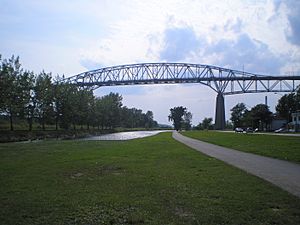
Trains
The Grand Trunk Railway (CN Rail) built a train line through Cornwall in 1856. The New York and Ottawa Railway (NY&O) added a line in 1898. Canadian Pacific also built a line, the Glengarry and Stormont Railway, in 1915. This connected to CP's main line to Montreal.
When the St. Lawrence Seaway expanded in the 1950s, it changed the city's train lines. CN moved its line north. The NY&O stopped using its line. A new CN passenger station was built in 1957. It is still used by Via Rail. The old Grand Trunk station was torn down in 1962. NY&O's passenger service ended in 1957. CP passenger service ended in 1952.
Today, Cornwall has one main train line, the CN Kingston Subdivision. This is CN's main line between Toronto and Montreal. It is also part of Via Rail's Québec City-Windsor corridor. Passenger trains between Montreal and Toronto stop at the Cornwall railway station. This station is in the city's north end.
Street Railway
Around 1900, Cornwall had an electric street railway system. It carried goods and people around the city. The Cornwall Street Railway started passenger service in 1896. Freight service began in 1899. Passenger service ended in 1949. It was replaced by trolleybus service. Electric freight service ended in 1971. The street railway was important for the city's growth. Its passenger service eventually became the current Cornwall Transit bus system.
Public Transit
Cornwall Transit has 24 buses. It operates six days a week, but not on Sundays or holidays. It has fixed routes and extra routes during busy times. There is also a "Handi-Transit" service for people with disabilities. Cornwall Transit carries about 860,000 passengers each year.
Air Travel
Cornwall is served by the Cornwall Regional Airport. It is about 10 kilometers (6 miles) east of the city. The airport is open all year. It has a 3,500 by 100 foot (1,067 by 30 meter) runway and a terminal. The Canada Border Services Agency is available upon request. Cornwall Aviation offers charter flights from the airport.
Massena International Airport in New York is a 20-minute drive from Cornwall.
Sea Travel
The City of Cornwall is on the St. Lawrence Seaway. It is just east of the Eisenhower and Snell Locks. The Cornwall Harbour and Government Wharf are on the north bank of the St. Lawrence River. They are located in the city's east end.
Learning in Cornwall
Cornwall Collegiate and Vocational School became a school for grades 7–12 in 2011. The school celebrated its 200th anniversary in 2006. It is one of Canada's oldest schools. It offers a full French immersion program for grades 7–12.
St. Joseph's Secondary School is a Catholic school. It also offers French immersion. The newest high school is Holy Trinity Catholic Secondary School. It is for grades 7 to 12. Both schools offer French immersion.
Cornwall also has two French high schools. L'École secondaire publique l'Héritage is a public school. L'École secondaire catholique La Citadelle is a Catholic school. Both serve students from grade 7 to 12.
St. Lawrence Secondary School also hosts students in grades 7–12. In 2012, it had its first graduating class of grade 12 students since 2003.
The 2016 census showed that 40% of Cornwall's population has a college or university degree or diploma.
A campus of St. Lawrence College is in Cornwall. The St. Lawrence River Institute of Environmental Sciences is on the college campus. It offers an Environmental Technician program. This institute studies river systems, especially the Great Lakes/St. Lawrence River.
Al-Rashid Islamic Institute is the first Islamic school of its kind in North America. It offers higher education in Islamic studies with boarding.
The Seaway Valley Meat Cutting Institute is in Cornwall. It offers training programs.
Cornwall is home to the Canadian Forces School of Aerospace Control Operations (CFSACO). This school trains Canadian Forces personnel to be Air Traffic Controllers or Air Weapons Controllers.
Nav Canada used to train Air Traffic Controllers in Cornwall. The training center was sold in 2022. Nav Canada still uses part of the site for training.
Media in Cornwall
Radio Stations
| Frequency | Call sign | Branding | Format | Owner | Notes |
|---|---|---|---|---|---|
| FM 88.1 | CHRI-FM-1 | Christian | Christian Hit Radio Inc. | Rebroadcasts CHRI-FM Ottawa | |
| FM 92.1 | CHOD-FM | 92.1 GO FM | Franco-Ontarian community | La Radio communautaire Cornwall-Alexandria | |
| FM 95.5 | CBOC-FM | CBC Radio One | Talk radio, public radio | Canadian Broadcasting Corporation | Rebroadcasts CBO-FM Ottawa |
| FM 97.3 | CKON-FM | First Nations community (from Akwesasne) | |||
| FM 98.1 | CBOF-FM-6 | Ici Radio-Canada Première | news/talk | Canadian Broadcasting Corporation | French Rebroadcasts CBOF-FM Ottawa |
| FM 101.9 | CJSS-FM | Boom 101.9 | Classic hits | Corus Entertainment | |
| FM 104.5 | CFLG-FM | Fresh Radio | Hot adult contemporary | Corus Entertainment |
You can also listen to radio stations from Ottawa, Montreal, and New York.
Television
- Channel 8: CTV CJOH-TV-8 (repeats CJOH-TV Ottawa)
- YourTV
Print Media
- Cornwall Standard-Freeholder is the city's main daily newspaper.
- Seaway News is a weekly newspaper. It includes pages from the French newspaper L'Express.
- The Cornwall Seeker is a free monthly newsmagazine. It focuses on arts, culture, and events.
- Le Journal de Cornwall is a weekly newspaper. It mainly serves the French-speaking community.
Online News
- Cornwall Free News
Famous People from Cornwall
Many well-known people come from the Cornwall area:
- Barstool Prophets, a Canadian rock band, had three members from Cornwall.
- Darby Bergin, Canada's first Surgeon General.
- Malcolm Burn, a musician and record producer.
- Roger Caron, an author who won an award for his book Go-Boy!.
- Doug Carpenter, a former NHL coach.
- Alain Chevrier, a former NHL goalie.
- Lionel Chevrier, a former Member of Parliament.
- Corbett Denneny, a former NHL player.
- Cy Denneny, Corbett's brother, a former NHL player in the Hockey Hall of Fame.
- Lori Dupuis, an Olympic gold and silver medalist in women's ice hockey.
- Ryan Gosling, a famous actor.
- Christina Julien, a former member of the Canadian national women's soccer team.
- Chad Kilger, a former NHL player.
- Bob Kilger, a former NHL referee, mayor, and Member of Parliament.
- Ed "Newsy" Lalonde, who captained the Montreal Canadiens and helped them win their first Stanley Cup in 1916.
- Ed Lumley, a former mayor and Member of Parliament.
- John Sandfield Macdonald, the first Premier of Ontario.
- Don McKay, an award-winning poet.
- Duncan McNaughton, a gold medalist in high jump at the 1932 Olympics.
- Scott Pearson, a former NHL player.
- Nathan Phillips, a former mayor of Toronto.
- George Beverly Shea, a well-known gospel singer.
- Orval Tessier, a former NHL player, coach, and scout.
- Jesse Winchester, a former NHL player.
Sister City
Cornwall is connected with:
 Coventry, United Kingdom
Coventry, United Kingdom
See also
 In Spanish: Cornwall (Ontario) para niños
In Spanish: Cornwall (Ontario) para niños




